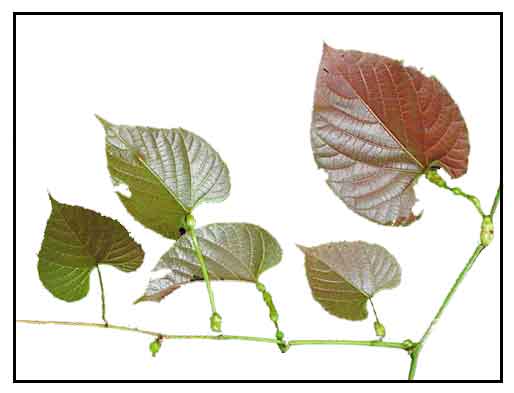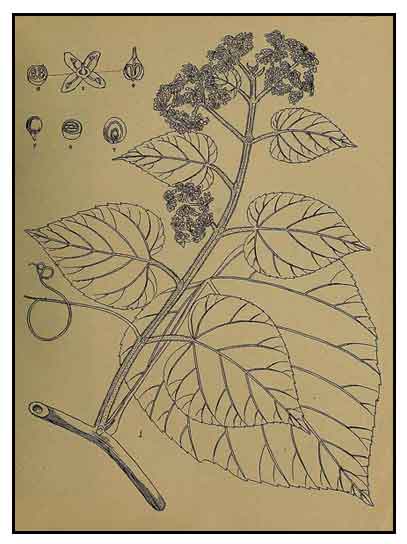 Botany Botany
Ayong-kabayo is a hairy vine reaching a height of at least 10 meters. Leaves are broadly ovate, 8 to 18 centimeters long, and 5 to 12 centimeters wide, with pointed tips, rounded or heart-shaped bases and toothed margins. Flowers are greenish with a purple tinge, subumbellately arranged on the ultimate branchlets on cymes 2.5 to 5 centimeters long. Fruit is fleshy, purple when mature, rounded and about 1 centimeter in diameter, containing a single, large, pear-shaped, smooth seed.
Distribution
- In thickets at low and medium altitudes, from northern Luzon to Mindanao.
- Also reported in India to Indo-China and southward to Timor.
Constituents
- Studies of bark, leaves, and roots have yielded vitisinol B, (+)-ε-viniferin, vitisinol C, vitisinol D, (−)-viniferal, ampelopsin C, miyabenol A, (+)-vitisin A, (+)-vitisin C.
- Phytochemical screening of an ethanol extract of leaves yielded yielded alkaloids, carbohydrates, flavonoids, phenols, terpenoids, saponins, and tannins. (see study below) (12)
Properties
- Considered alterative, diuretic, and blood purifier.
- Studies have shown antioxidant, anti-urolithiatic,
antibacterial properties.
Parts used
Roots and tubers.
Uses
Edibility
- Leaves cooked and eaten as vegetable.
Folkloric
- The Kalanguya tribe in Tinoc, Ifugao, Luzon, Philippines, use a leaf extract as mouth wash to treat mouth sores. (15)
- In India, the decoction of dried tubers used as alterative and as diuretic.
- Extracts have been used for dissolution and expulsion of urinary stones.
- Root, powdered and heated, applied to cuts and fractures by the Santals.
- In Bangladesh, plant traditionally used for treatment of boils, bruises, epilepsy, fever, food poisoning, gastric tumors, gingivitis, jaundice, gout, hysteria, snake bites, urolithiasis, etc. (8)
- In Kerala, India, decoction of tuber considered diuretic, alterative, and blood purifying. (9)
Others
- Cordage: Stem commonly used for cordage.
 Studies Studies
• Antibacterial / Anti-Urolithiasis: Study of 17 plant species screened for potential antibacterial activity against four selected urolithiasis-inducing flora (P mirabilis, E coli, Pseudomonas stutzeri and K pneumonia) showed six plants, including C. adnata to show promising roles in the prevention and cure of urolithiasis. (1)
• Free Radical Scavenging Activity: Study yielded a triterpenoid, flavonoid and apigenin. Study comparing isolated compounds of C. adnata and Smilax lanceaefolia showed the compounds to have moderate to high free radical scavenging activities. (3)
• Chemoinhibitory Effect / Antiurolithiatic: Studies on Cissus adnata have suggest antilithiatic property. An aqueous extract of leaves and isolated compounds showed an inhibitory effect on the formation of calcium phosphate and calcium oxalate stones in the urinary milieu. There was greater inhibitory effect on calcium oxalate formation than calcium phosphate crystal formation. (6)
• Antibacterial Efficacy on Urolithiasis Inducing Flora: In a study evaluating plants as sources of novel antibacterials associated with prevention and control of urolithiasis, Cissus adnata was one of the plants that exhibited significant antibacterial activity against four selected urolithiasis inducing flora (P. mirabilis, E. coli, Pseudomonas stutzeri, and K. pneumonia subsp. pneumonia), showing promising role in the prevention and cure of urolithiasis. (7)
• Biological Activities: Study evaluated the in vitro polyphenol content, antioxidant activity (DPPH radical scavenging, ferric reducing power, and total antioxidant capacity), cytotoxicity (brine shrimp lethality assay), antibacterial (disc diffusion method), anthelmintic property (aquarium worm Tubifex tubifex), and in vivo antinociceptive activity(acetic acid and formalin test in mice) of an ethanol extract of C. adnata leaves in different experimental models. Results showed the ethanol extract possess strong antioxidant, antibacterial, anthelmintic, and antinociceptive activities with lower toxicity. (12)
• Antioxidant Activity: Study evaluated the antioxidant activity of C. adnata using methanol and various fractions of whole plant. Among all fractions, aqueous soluble fraction showed the highest total phenolic content of 34.65 mg of GAE / gm of extractives compared to others. On DPPH free radical scavenging assay, petroleum ether fractions showed highest IC50 of 546.29 µg/ml. (13)
• Ascorbic Acid and Tocopherol Content / Anti-Inflammatory: In a study of ten medicinal plant extracts of Manipur with anti-inflammatory properties, Cissus adnata showed highest ascorbic acid equivalent with 48.08 mg/100g, with tocopherol content of 3.5 mg/100g. (14)
Availability
Wild-crafted.
|

![]()




 Studies
Studies 